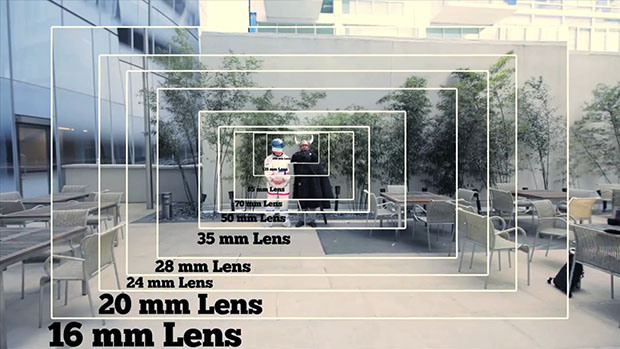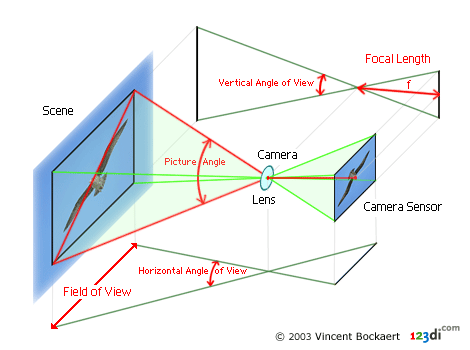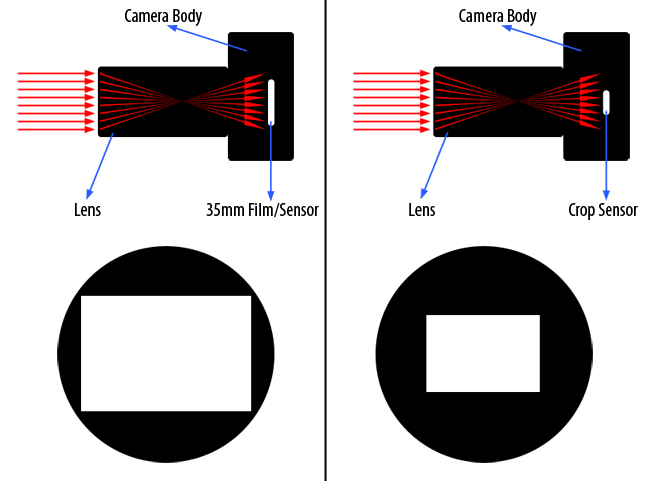This post explains some of the hidden secrets of camera lenses. It will help you compare lenses against one another, explaining focal length and the 35mm equivalent (more on that later). It's very important to understand this concept given a camera market in which there are so many different sensor sizes.
Note that this post is based on research I did for working with RGBDToolkit - but anyway it applies to all cameras. At the end of this post I'll double back and explain how this helps us choose a lens for use specifically with the RGBDToolkit.
Narrow vs. Wide
We've all see images like the one below (taken from Vimeo's Behind the Glass series), showing the effect that different 'focal lengths' have on the crop of the image we see:

Using different focal lengths, we can zoom right in and get great detailed shots of faces (200mm), or take a really wide angle shot that captures the entire scene (16mm). For reference, the human eye focal length is about the equivalent of the 50mm focal length in the picture above.
(Ofcourse, this image doesn't mean that zoom lenses are best - you will always get the best quality with lenses made specifically for a given Focal Length).
Here's a quick explanation of some common Focal Lengths and their general uses (again, from Behind the Glass):
- 16mm
"An ultra wide lens, this bad boy distorts heavily, emphasizing objects in the foreground by making them look a lot larger than the background. Dynamic, but use with caution!" - 28mm
"Standard for documentary and photojournalism to shoot cowboy shots, otherwise known as medium shots." - 35mm
"Another standard for documentary filming, also tight enough to shoot portraits." - 50mm
"Standard for cinema/video, it approximates the human eye's typical focal length." - 85mm
"A popular portrait, or 'beauty' lens. Capable of making everyone look lovely!" - 200mm
"The top of the scale for most people, this is a telephoto lens. Their inherent shallow depth of field makes them useful in eliminating unwanted foreground and background objects by simply throwing them out of focus. Great for sports photography!"
And that's great - but what really is Focal Length? What do these numbers mean? What does 200mm and 16mm refer to?
What is Focal Length?
It should start to become clear if you take a look at the image below. We can see that focal length is the distance between the lens and the Camera Sensor.

We can imagine that when the lens is further away from the Camera Sensor (say, 200mm) the picture angle and therefore Field of View (FOV) becomes narrower - a narrow angle lens. In the picture above, the bird's wings would be cropped off and we'd have a tight close-up.
We can equally imagine that if the lens is closer to the Camera Sensor (say, 16mm) the FOV will be wider and the the picture will be of a smaller bird with much more sky - a wide angle lens.
So what does the 35mm mentioned at the top of this post refer to?
Everything revolves around 35mm Camera Sensors
There is a different measurement in millimeters which does not describe the Focal Length. Instead, when we say '35mm sensor' we are describing the size of the Camera Sensor (look back at the diagram above).
It's a hangover from the days of film. The standard, canonical size of Camera Sensor is based on the standard, canonical size of film - 35mm.
Now, a 50mm Focal Length has a certain angle of view associated with it - as illustrated in the first picture at the top of this blog post - and a 200mm Focal Length also has a certain view angle associated with it. But when we use the numbers 50mm and 200mm to describe an angle of view, we do so assuming a 35mm Camera Sensor.
In fact all of the angles shown in the image at the top of this post are labelled with the commonly used language of Focal Lengths - 50mm, 200mm etc, and this language is ubiquitous. But the actual millimeter Focal Lengths used to achieve those shots depend on also using a 35mm Camera Sensor.
For example
So what happens if we use a smaller sensor? With the same lens?
Let's imagine we use exactly the same 50mm lens on both a 35mm sensor, and then on a sensor half that size (17.5mm).

The net effect is something like this - the smaller sensor has a narrower FOV for the same Focal Length:
To achieve the same FOV, you need to shrink down the entire lens, Focal Length and all, by half:

In fact, this is one of the selling points of the standards described below. The smaller sensors mean you can have smaller, lighter and less imposing-looking camera lenses.
Common standards
Three common standard size formats have grown up for three different sensor sizes:
- Micro Four-Thirds (2 x focal length)
- APS (1.5 x focal length) - most mirrorless DSLRs
- Full Frame - same size as a 35mm camera
The Micro Four Thirds standard is exactly half the size of the Full Frame (35mm), and so whatever focal length you have for a Micro Four Thirds lens, you can double it to get the 35mm equivalent.

The APS standard is midway between the Micro Four Thirds and the Full Frame, and so whatever focal length you have for an APS lens, you can times it by 1.5 to get the 35mm equivalent.
For example, the angle of a 14mm Micro Four Thirds is roughly equivalent to a Full Frame 28mm.
So the next time someone tells you they have a 50mm lens, ask them what size sensor they have and scale up before building a picture in your mind of the FOV it will produce!
Which lens for the RGBDToolkit?
When finding a lens to use with the RGBDToolkit, we are looking to find a lens with a similar, but if anything slightly wider FOV. The makers of RGBD recommend a ~24mm lens on a Full Frame sensor, so a 12mm lens on a Micro Four Thirds. They also recommend a ~16mm lens for an APS-C sensor like an entry-level Canon DSLR.
So it's pretty simple really, but now you have some context as to why those settings are appropriate relative to each other, and some sense of the FOV you can expect at the end. And as the RGBDToolkit tutorial says: "When in doubt, set your zoom lens to its widest setting. Use a wide prime lens for best results."
(*) -- I know this isn't really a Micro Four Thirds sensor on the right of the image. It's a slightly smaller sensor. But it's a really nice image, and the article just flows a little better if we just pretend it is, don't you think?